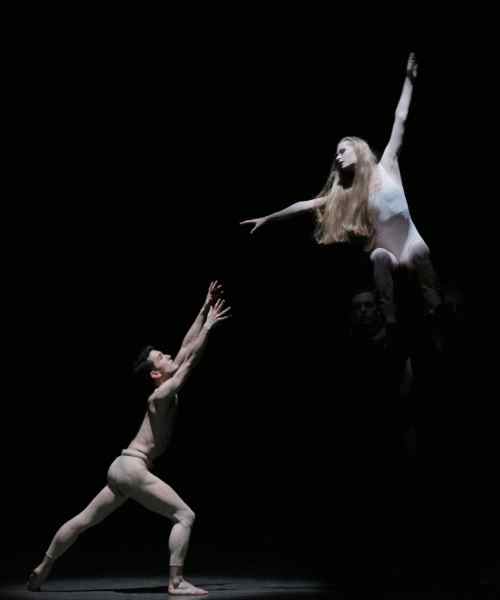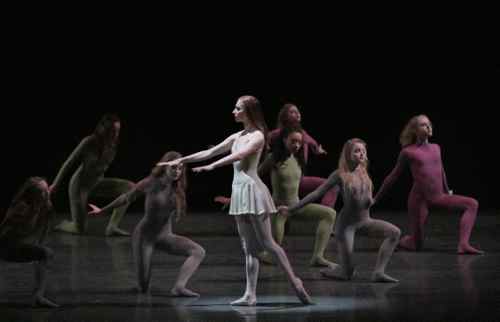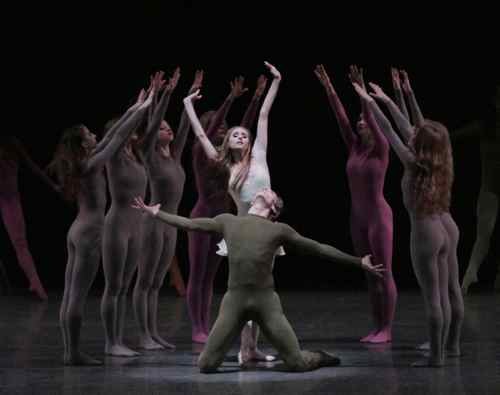“I don’t have to tell you that Mr. B is with Mozart and Tschaikovsky and Stravinsky,” Lincoln Kirstein announced to the New York City Ballet audience, exactly 30 years before the company’s April 30 opening night this season. The program, which inaugurated City Ballet’s three-week American Music Festival attracted a good house and fervid audience enthusiasm for two big pieces easy on both eye and spirit: Who Cares? to Gershwin songs (their lyrics unsung, but engraved in popular memory; Tiler Peck at her familiar finest) and Stars and Stripes (Hershy Kay, after Sousa, the master of marching), plus one tiny one—the amuse-bouche Tarantella.
 Janie Taylor and Anthony Huxley in George Balanchine’s Ivesiana
Janie Taylor and Anthony Huxley in George Balanchine’s Ivesiana
Photo: Paul Kolnik
The piece awarded only a tepid reception was the one I went to see—the 1954 Ivesiana, named for its composer, Charles Ives. It seizes the imagination and always in different ways; its message is up to the interpretation of the viewer. The message, however, is never heartening.
The piece opens and closes with a largish group in unremarkable practice clothes of dull hues, people locomoting on their knees, the rest of their body erect but subdued, their destination undefined and unexplained—perhaps a useful image for sociologists. Human assets such as will and imagination—even intention—seem to have died in them long ago. They are, of course, incapable of mourning what they’ve lost. They’re indifferent, emotionally hollow.
Balanchine’s first stroke is right on the mark: the curtain rises on a full blackout. Then, slowly, a little light comes up; witnessing this is like the beginning of arousal from deep anesthesia. Viewers see a knotty cluster of people on their knees that slowly fans out as if merely to create a breathing space. Still the claim of that larger space registers as a warning and a threat.
Ashley Laracey and members of the ensemble in Ivesiana
Photo: Paul Kolnik
A young woman in a white tunic, hair unbound (Ashley Laracey), wanders through the still-dense forest of kneeling bodies. Her hands palpate the air directly before her, as if she were not simply lost but blind as well. Worse yet, she’s joined by a man in a grey unitard—anonymity personified–and together they make their way through the crowd. So far the narrative might have been coveted by some contemporary equivalent of the Brothers Grimm.
Ashley Laracey, Zachary Catazaro, and members of the ensemble in Ivesiana
Photo: Paul Kolnik
Throughout, the stage remains ominously dark. The girl appears to be running away from the man. Inevitably, he captures her and then leaves her inert body with a group of the anonymous people, as if for dead. The nameless crowd clusters behind the body—fulfilling its mission, as it were—and disappears into the velvety, fatal dark as, presumably maimed and sightless, the girl is once again let loose and tries to find her way. The section described above is called “Central Park in the Dark” and, having lived half a block away from the site, I can attest to the fact that the narrative has many factual roots.
The second section, “The Unanswered Question,” originally featured the incomparable Allegra Kent whose extreme plasticity, coupled with a supercharged poetic imagination, made her role unforgettable. Now Janie Taylor, partnered by Anthony Huxley, takes the leading role, but creatures like Kent are never replaceable. Four men in black (they’re hardly visible) manipulate the woman so that her partner can almost reach out and touch her but never does, clearly never will; she remains forever just beyond his reach. The supporters hold her aloft, erect, like a revered icon, and then, in a thrilling, danger-laden single swoop, she drops backwards. In a few seconds her supporters have her standing in the air once again.
A third section, called “In the Inn,” finds a man and woman (the dangerously good-looking Amar Ramasar, who overacts, and the lush Sara Mearns) enjoying the simple pleasure of a mix of social dances. In the viewer’s imagination, however, the horrors implied in what went before the joy make the halcyon images seems ironic or at least unworthy of trust.
The closing section, “In the Night,” gives us the full cast once again, walking unremittingly on its knees in the near dark to one side or the other of the stage, some exiting into the wings, some still “caught” mid-stage as the curtain falls. Unlike Who Cares? and Stars and Stripes, Ivesiana makes no effort to “entertain” its audience; it is there to make us recall our worst nightmares (asleep or awake) and to marvel at the fact that the most profound ideas and feelings can be expressed (often best expressed) without a single word.
The entire program was extraordinarily well danced.
© 2013 Tobi Tobias






This entire review is extraordinarily well written.
Thank you, TT, for the blow by blow, play by play account of a ballet that is very much on my mind at the moment, Janet Reed having originated the role of the “blind girl” (and according to her, she was indeed meant to be blind) in “Central Park in the Dark,” and Todd Bolender having originated the yearning partner in “The Unanswered Question.” I’m glad all three pieces were extraordinarily well-danced; Stars and Stripes has always left me cold and the charm of Who Cares? eludes me, although a performance of excerpts by students and Oregon Ballet Theatre company members in the School of OBT’s annual concert was danced with such zest, and in a couple of cases really fine technique, I found myself enjoying it.
I’m going to a couple of performances just to see Ivesiana, and am very grateful for your description and your enthusiasm.
Ivesiana is indeed a remarkable work, perhaps not to be seen too often, to preserve its special feeling but also a work that should never be long out of the active repertory. However well danced (if that be the word), the opening has never had quite the same effect after the move to the New York State Theater in 1964 that it had at City Center.
At the State Theater, with those “headlights” on the sides of the rings picking up any smidgeon of light as well as the glowing exit signs, it is never completely dark as the curtain goes up, while as I recall it at City Center, even the few exit lights were extinguished when the house lights and those in the orchestra pit were turned off, so that the rising of the curtain was never seen, making even more eerie the slow bringing up the few lights on the stage. It was indeed the atmosphere of a dream, created through the simplest but most effective means. Magic indeed, and a haunting image never to be forgotten.
Tobi, thank you (once again) for sharing your insights and interpretations. I’m off to see this program this afternoon. While Ivesiana sounds profoundly disturbing, I am looking forward to experiencing it. I wonder what Balanchine was thinking when he created this ballet. I appreciate the framework that you have provided, which I am sure will enrich my experience. Ann
Dear Tobi,
It was with great interest that I read your detailed review of Ivesiana. Your vivid descriptions made it possible for me to visualise the performance.
Thank you for sharing!
Thank you! I was there too.
Ivesiana has been out of NYCB’s standard repertory for many years–at least a decade, I think, and maybe more. Too bad. It shows a unique side of Balanchine that I hope won’t be absent for nearly as long the next time.
How very, very dark this ballet is–literally and figuratively. Even the sunnier “In the Inn” pas de deux has a cloudy edge. I’m assuming Balanchine responded to something in the music, but it would be good to know more. Maybe a “Hear the Music” session would help.
Do you remember the sections that were eliminated? Do you know if anyone has written about them?
This is a small masterwork, and it was beautifully danced. I, for one, am eager to see it again. And again.
And, P.S., wasn’t the rest of the program a treat? What a marvelous company!
I just returned from an afternoon at NYCB, watching Balanchine’s various responses to American music. Like some of you, I went to see Ivesiana and was so glad to have the opportunity. This has to be one of the most enigmatic pieces made by Balanchine and to me, not much like any of his other works. I was very glad to have read Tobi’s review before I went and I’m hoping I might see it again later this season. Once is not enough.
The company is looking very fine. Several of the ballerinas were on display this afternoon and all were captivating. I’m paying close attention to Sterling Hyltin these days.
Across the Plaza, this evening, the Met’s revival of a legendary production, Dialogues des Carmelites. Like Ivesiana, this Poulenc gem has been out of the repertory for about ten years. I grabbed the chance to see it earlier in the run. Who knows when I’ll ever get another chance?